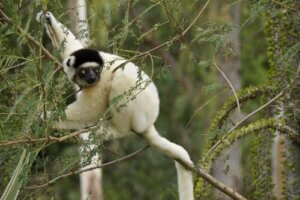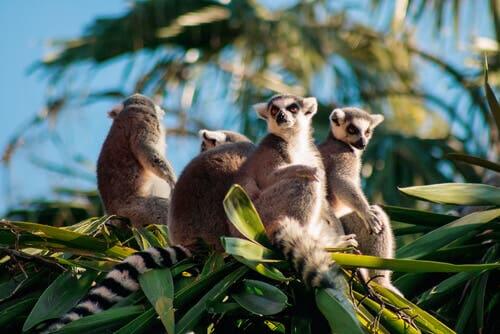The Unique Characteristics of Lemurs


Written and verified by the vet Eugenio Fernández Suárez
The lemur belongs to one of the most interesting primate groups on the planet. Now, some people think that there are only one or two species–those that have appeared in animated movies. But the truth is, the term lemur refers to more than 100 species that inhabit all of the ecosystems in Madagascar. In today’s article, we’ll tell you all about the unique characteristics of lemurs.
What does lemur mean?
The term lemur comes from the word Lemure, which, for the Romans, were spirits of death. And, in general, they associated this term with evil spirits that they needed to protect themselves from.
It was Carl Linnaeus who suggested the name lemur for these singular primates. That’s because during this westerner’s first visits to Madagascar, in the thick of the jungle, the nights were full of the shrill shrieks and bright mysterious eyes of these primates.

Some people think that there are only one or two species of lemurs–those that have appeared in animated movies. But the truth is, the term lemur refers to more than 100 species that inhabit all of the ecosystems in Madagascar.
The unique characteristics of lemurs
Lemurs are Strepsirrhinis or, in other words, wet-nosed primates from Africa and Asia. These animals, like every other primate, have hands and feet with five fingers/toes, opposable thumbs, and nails instead of claws.
However, they also possess certain characteristics that set them apart. The unique characteristics of lemurs include a proportion between the brain and body mass that’s lower than that of other primates. In addition, lemurs have a more developed rhinarium and low basal metabolism. This determines very rare characteristics among primates, such as seasonal reproduction and hibernations.
Given that long rhinarium–or snout–the sense of smell is very important for lemurs. They also have a very developed vomeronasal organ, which specializes in the detection of pheromones. So, lemurs leave their marks with urine or with scent glands that they have in their necks, underarms, and other parts of their bodies.
Another one of their most important means of communication is auditory. Most lemurs have a wide range of vocalizations. These range from the howls of the ring-tailed lemur–the most well-known species–to the strident barks of the ruffed lemurs.
Lemurs are social animals that live in groups, or “conspiracies”, of at least 15 members. And that takes us to another one of the unique characteristics of lemurs. One of their most important behavioral characteristics is that lemur societies are matriarchal.

Given their long rhinarium–or snout–the sense of smell is very important for lemurs. They also have a very developed vomeronasal organ, which specializes in the detection of pheromones. So, lemurs leave their marks with urine or with scent glands that they have in their necks, underarms, and other parts of their bodies
Madagascar: Lemur kingdom
Another one of the unique characteristics of lemurs is that, as we mentioned before, they live exclusively on the island of Madagascar. While it may seem like a small piece of land, Madagascar actually has a larger surface than that of a country such as Spain.
Lemurs have adapted to the different ecological niches of this island. As a result, the variability among these primates is very high, and they differ greatly from the rest of the primates on the planet.
In fact, among this group of animals, we can find the largest primates in the world, as well as the smallest. On the one hand, we have the mouse lemur, which weighs only about an ounce. And on the other hand, we have the now extinct Archaeoindris fontoynonti. This giant lemur species weighed some 400 pounds and rivaled the gorilla.
Madagascar is a great example of how invasive species affect ecosystems. 500 years ago, man began leaving cats and other species in its diverse ecosystems, which led to the extinction of dozens of bird species.
In this sense, some 2000 years ago, human beings were an invasive species in this country. And, since then, they’ve destroyed almost 20 species of these primates.
Despite that, there are still more than 100 remaining species of lemurs, all of them possessing impressive characteristics. From the bamboo lemurs which are mysteriously immune to cyanide, to the sifakas, who leap and skip instead of walking. We hope all of these species can continue to live in peace for many years in their unique paradise.
This text is provided for informational purposes only and does not replace consultation with a professional. If in doubt, consult your specialist.